Welcome to Close Reads! In this series, Leah Schnelbach and guest authors will dig into the tiny, weird moments of pop culture—from books to theme songs to viral internet hits—that have burrowed into our minds, found rent-stabilized apartments, started community gardens, and refused to be forced out by corporate interests. This time out, writer and cultural critic Sarah Welch-Larson knits a colorful tale of fandom, Doctors, and very long scarves.
When I first got into Doctor Who, I wanted to let everyone else in my orbit know about it. Because I was seventeen years old, I had to do so in the most dramatic way possible, so I did what any dedicated fan would do: I bought seven different colors of yarn and I knit my own version of The Scarf.
It’s appropriate that the most recognizable symbol of Doctor Who that I could think of wasn’t from the same incarnation of Doctor Who that I was watching at the time. It wasn’t even from the same century. My introduction to the show was David Tennant’s tenure during New Who in the early aughts, but The Scarf was integral to the wardrobe of the fourth incarnation, played by Tom Baker during the Classic Who series in the 1970s. At the time I liked to think that wearing a symbol of the classic show somehow marked me as being a more serious and more dedicated fan than the friends I had who only watched the more recent seasons…even though I preferred the more recent seasons myself. But by repurposing an anachronistic costume piece, I was living out the show’s playful irreverence for and affection toward its own history. I was also following the Doctor’s own costuming choices by using an eccentric wardrobe piece to try to assert a part of my own identity.
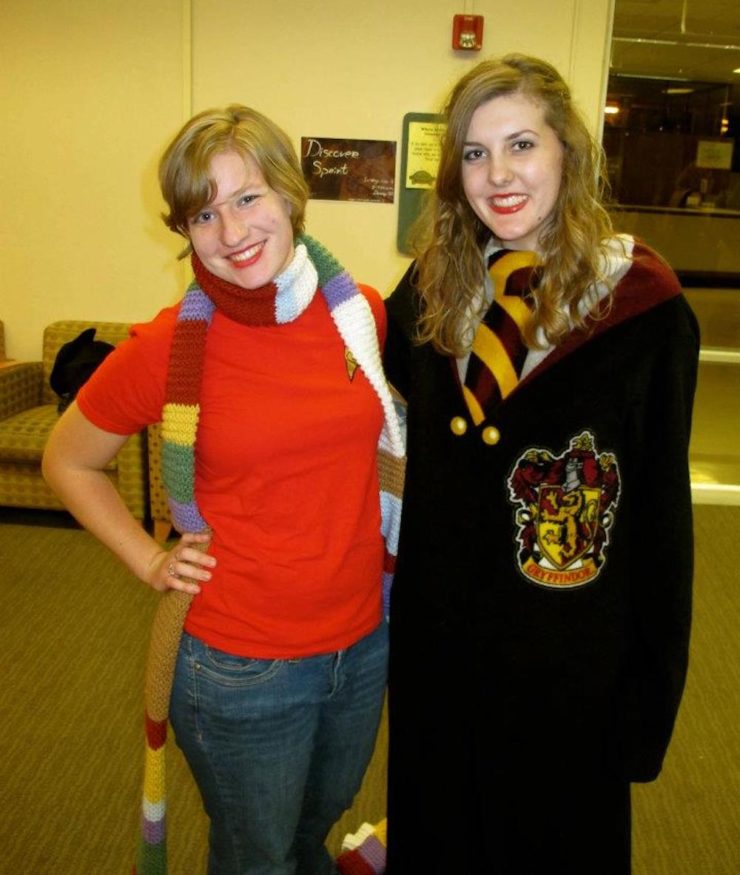
Doctor Who is the ultimate time travel show. Its episodic nature and its habit of swapping out the actors who play the titular role grants new viewers freedom to choose wherever they’d like to start watching; in effect, the viewer can choose to time travel throughout the show, dropping into each story in the same way that the Doctor drops in on historical events. The only real constant is the show’s embrace of change.
Doctor Who’s space/time travel conceit allows the show to take place at any place, in any time; its serialized structure allows it to loosely string together unrelated stories into one long romp. (David Tennant’s Ten famously refers to the course of history as a “wibbly-wobbly timey-wimey ball.”) Although some incarnations of the Doctor—like Peter Capaldi’s Twelve and Colin Baker’s Six—skew grim, the show overall maintains an attitude of playfulness. Tom Baker’s Four has a habit of offering candy to everyone he meets, including his adversaries; David Tennant’s Ten engages in frequent wordplay; Peter Davison’s Five wears a stalk of celery on his lapel.
Buy the Book
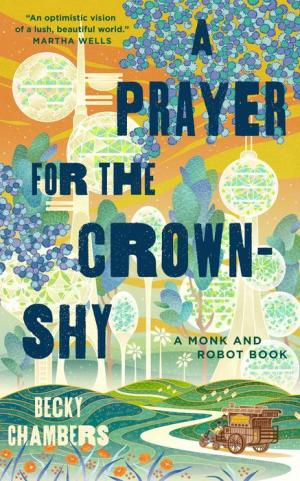

A Prayer for the Crown-Shy
This playfulness extends to the show’s own timelines and canon. Nothing is truly sacred in Doctor Who; even when the Doctor’s home planet is destroyed in the hiatus between Classic and New Who, it’s eventually brought back through a loophole in time. In the show’s continuity, time is a malleable thing with very few fixed points. The show calls back to previous episodes all the time, even if they’ve been erased from canon. This makes for fertile ground for creative storytelling—the BBC has produced an astounding number of official books and audio dramas, not to mention over fifty years’ worth of TV episodes.
Fans of the show take advantage of that fertile ground as well. It’s possible to write fanfiction set in any time, at any place, with any other characters from any other story, and still have a piece of fanfiction that is distinctly Doctor Who, provided that a certain time-traveling alien pops in. (Archive of Our Own alone currently lists more than 100,000 works under a Doctor Who tag.) Fans have the freedom to drop the Doctor into whatever story they’d like, making the character both ubiquitous and entirely their own.
It’s in this spirit of playful creative license that I made my version of The Scarf. There are patterns all over the internet for making screen-faithful copies of The Scarf, but my version is not an exact replica. The stripes are correct—I did follow a pattern—but the colors are all wrong. They’re late-aughts pastels instead of the screen version’s 70s earth tones; I chose them because they were the cheapest soft yarn I could find on a student budget. I was also new to the craft, so I knit my scarf with the slightly-too-loose stitches of an amateur, looping the scarf across my dorm room as I worked. It’s possible that it stretched even longer than the screen version’s canonical fourteen-foot length. I had to roll it up to keep it from taking over my side of the room.
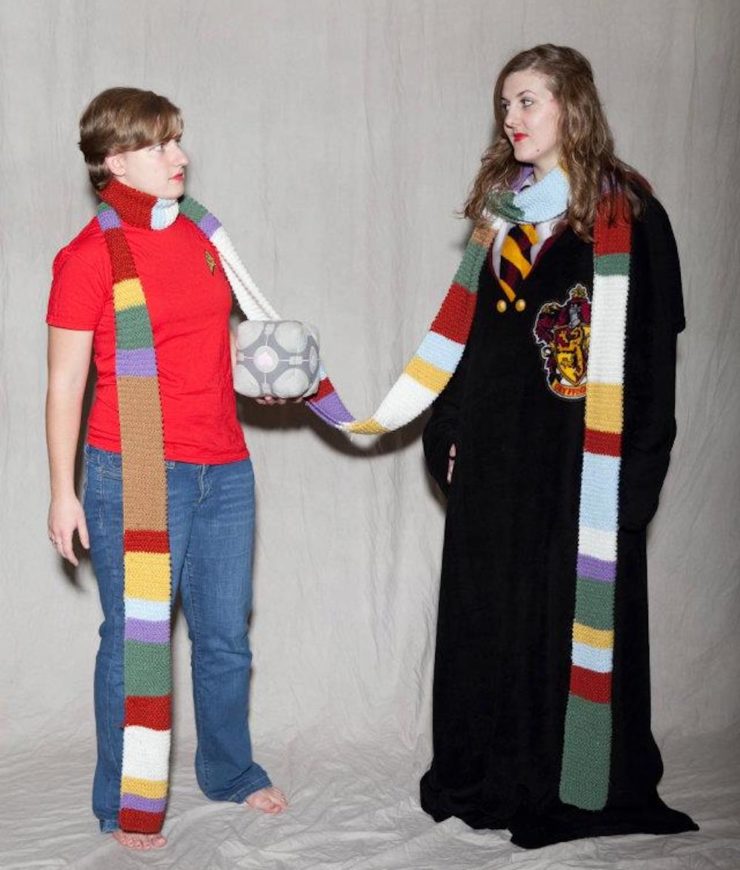
I felt slightly self-conscious about the incorrect colors when I made the scarf, but I wasn’t entering any cosplay competitions, so the mismatch didn’t matter much. None of my friends cared enough about Doctor Who to nitpick the colors. Besides, Tom Baker’s Four didn’t even wear the same scarf all the time; one on-screen variation was all red and purple. My scarf was still recognizable as The Scarf. It was a physical representation of my love for the TV show, something that other fans would acknowledge whenever I wore it out in public. I even had a college professor who wore a more faithful replica of The Scarf that his wife had made him; we’d grin and nod whenever we both wore our scarves to class on the same day. The colors didn’t make my scarf any less a Doctor Who homage; they grounded it as a handmade artifact, unique in its imperfection, something referencing a beloved TV show and also completely my own.
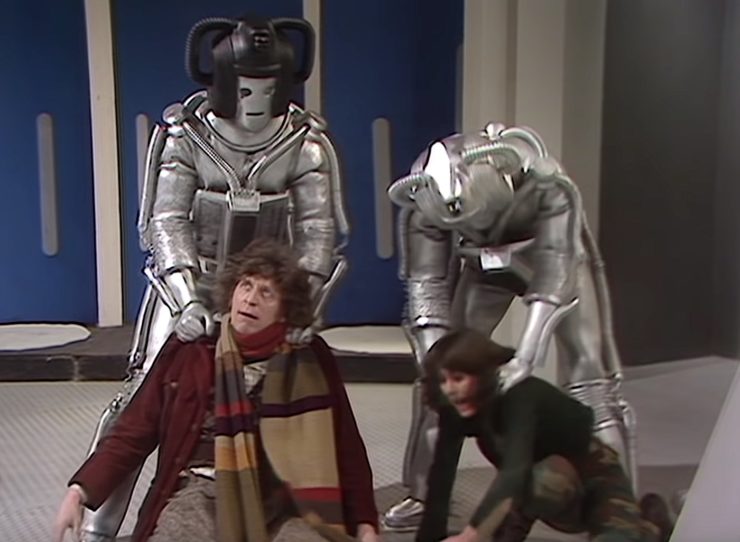
Doctor Who celebrates how it feels to be a physical being, to be alive and inhabit a body. Every time the Doctor regenerates, the character spends an episode or so running around manically in their predecessor’s clothing, trying to save the world in the midst of having their own identity crisis. David Tennant’s Ten, freshly regenerated, pauses mid-speech to comment about how weird his new teeth feel in his mouth. Jodie Whittaker’s Thirteen moves her limbs jerkily, as though she’s unused to piloting her body; Tom Baker’s Four compares getting used to his new body to “settling into a new house .” My own choice to make and wear The Scarf could very well have been a version of my own regeneration; I was in college, building an identity for myself, trying on quirks to see how well they fit. I didn’t wear The Scarf in public for very long; by the time I moved out of the dorms, The Scarf became a decoration, and eventually I lost it.
Newly regenerated versions of the Doctor will complain about the way the previous incarnation’s clothing fits; they don’t feel like themselves until after they’ve saved the world and assembled a new wardrobe that reflects their personalities. Jon Pertwee’s Three and Peter Capaldi’s Twelve both dress like magicians, as befits their slightly aloof personalities; Christopher Eccleston’s Nine wears a leather jacket like armor as a reflection of his PTSD. Each of them chooses how to present their personalities to the world through their clothes.
The show is unapologetically optimistic about human nature, sometimes to a fault. I suppose I was also being overly optimistic when I made my replica of The Scarf. It’s difficult to take anyone wearing a fourteen-foot-long scarf seriously. It’s unwieldy. You have to loop it two or three times to keep from tripping over it, and it will still fall down to your knees. I don’t think I wanted to be taken seriously when I wore it; I wanted to be taken as a serious fan of a TV show that I loved, and that I wanted other people to love. When I stopped wearing it, it was because I wanted to be taken as a serious person in a different sort of way. When I made my version of The Scarf, I was doing the same thing as the characters on the show: I was declaring my allegiance to a humanist time-traveling alien by co-opting part of his costume. I was wearing my heart—and my love for the optimism of the show—quite literally around my shoulders.
Sarah Welch-Larson is interested in feminist theory and theology, sad men in space, and stories about agency and creation, especially when they include cyborgs or androids. She is the co-host of the Seeing & Believing podcast, a staff writer at Bright Wall/Dark Room, and the author of the book Becoming Alien: The Beginning and End of Evil in Science Fiction’s Most Idiosyncratic Franchise. She lives in Chicago with her husband, their dog, and about three dozen houseplants.










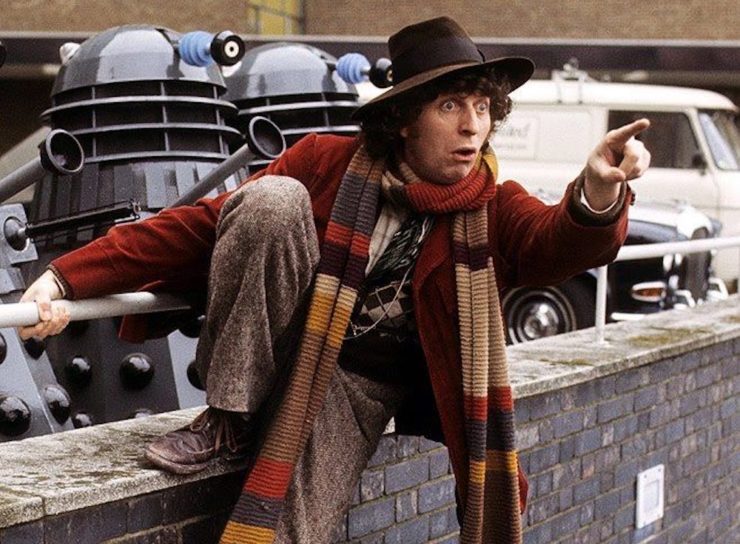
Your Scarf looks just fine! I am contemporary with the Tom Baker Doctor and have made a few Scarves. Recently I’ve gotten into the British archaeology show, Time Team, and felt moved to make myself a Stripey Jumper.
Great knitting! I tried to learn to knit and went back to whatever I was crocheting then as a coping mechanism.
My first eppy of Doctor Who was the last twenty minutes of Logopolis, encountered on PBS while I was channelsurfing, so Five is THE Doctor, lol. However, years ago, after seeing how many earth-toned rolls of crochet thread I had, I ditched the idea of potholders (wouldn’t match the kitchen anyway) and made a very long Four scarf :).
I am also Team Baker: “Four is the One True Doctor and Sarah Jane is his Companion”
I also note that the Scarf should if possible be accompanied by the Hat.
I squee’d big time at the ending of the 50th anniversary show when Tom showed up. I also cheered when War Doctor mocked the Modern Who concept of the sonic screwdriver as some kind of magic wand/phaser/etc by saying “it’s a screwdriver. What are you going to do, assemble a cabinet at them?”
I am pleased as punch that classic companions are coming and hope that Tom Baker can make more guest appearances while he is still available…
When I became a Who fan back in the ’80s, I came into possession of a set of instructions for making a Tom Baker scarf, and though I couldn’t knit, I had a friend who agreed to make it for me if I bought the yarn myself. So I searched around and gradually collected all the right colors and amounts of yarn, but somehow I fell out of touch with that friend for a while and things never came together, and I ended up having paid for a whole bunch of yarn that I never used.
On the subject of newly regenerated Doctors in their predecessors’ outfits, let’s not forget the ultimate fate of the scarf (at least the red-and-purple one from Baker’s final season) — the Fifth Doctor unraveled it to use as the equivalent of Ariadne’s thread while trying to find his way through the labyrinth of the TARDIS interior. It was a blatantly symbolic way of literally tearing down the iconic image of Baker, the longest-running Doctor.
@3/Dr Thanatos: “I also cheered when War Doctor mocked the Modern Who concept of the sonic screwdriver as some kind of magic wand/phaser/etc”
That’s hardly modern. It gained functions well beyond a screwdriver very early on. The Second Doctor used it as a cutting torch at least once. The Third Doctor used it as an all-purpose security disarmer, a sensor device, a hypnotic device, etc., and the Fourth was able to repair or modify pretty much any equipment with it.
I think what the War Doctor was mocking was the way both Ten and Eleven brandished their screwdrivers as if they were weapons, when it’s supposed to be a tool, closer to a tricorder crossed with a futuristic Swiss Army knife than a phaser.
@@.-@ I do not think we are disagreeing . There is a world of difference between “this is a very versatile tool” and “this is everything including a weapon and it’s my magic wand.” War Doctor fo the win!
@5/Thanatos: Still, I don’t see the problem. The Doctor is a tinkerer. It makes perfect sense that they’d just keep adding more and more functions to the sonic screwdriver over the years. It would be out of character if they didn’t.
The one thing that bugs me about the modern screwdriver is the way the Doctor uses it like a tricorder and looks at it for a readout, even though there’s no visual display on it (though I think Thirteen’s screwdriver has one). My handwave is that the Doctor’s reading some kind of telepathic projection.
Love this. I also knitted a very long scarf back in the 80s when I first got into Doctor Who in the form of endlessly cycling reruns of Four and Five on PBS; can’t call it The Scarf because I just used whatever yarn my mom had around the house (and some of it was actually rug yarn, so not actually soft enough to be wearable). Then a few years ago, when I was running a knitting program at my library and needed a simple project I could put down at any point, I did another, also not screen-accurate; the colors are closer, but I devised my own stripe pattern based on the Fibonacci sequence.
Tom Baker used to say he wanted to see an alien planet where they so admired the Doctor they all started to dress like him, so that he could drill them in tripping over their scarves. 10/10, would watch.
I love this description of being a fan: when you discover something that is older than you thought you very often want to dive into its history and find out everything that you may have missed. It’s not weird at all, just the sign of a keen and happy mind.T
Also, re the screwdriver: in Flatline, Clara takes the sonic screwdriver from the Doctor and ignores his instructions and says something along the lines of “just point and think” which corroborated the “magic wand” nature of the device. Twelve also built a sharpie into his screwdriver, so yes, I also run with the “Swiss army knife” school of thought.
Oh – the Fourth Doctor might have offered sweets or jelly babies but he’d never call it candy I’m afraid …
I think all the arguments which Doctor is better are … moving the air…
The important thing is that this is the best SF show ever. ;)
My favorite moment with Tom Baker never aired — I saw it on a blooper reel. Baker is running (naturally) down a hill and has an umbrella in hand (I don’t know how the umbrella tied into the plot but anyway…). So he’s running and his hat sails off and lands behind him. Baker, in one smooth motion, stops, turns and in a fencing lunge skewers the hat with the umbrella. Then he turns back to the camera with a big grin as if to say “Ha-ha, I foiled you, evil hat!” and then starts jogging up the hill for the re-take. It was great to see that grin again in the 50th anniversary show.
For me, Dr Who fandom started when I war around 13. Dr. Who came on at 5pm on weekdays on PBS and I had baseball practice at 6:30pm. So mom would have dinner ready for when my dad got home at 5, we’d all eat together and then my dad and I would rush out to baseball practice, sometimes even talking about the show (My dad isn’t and wasn’t a big talker lol).
Thanks for sharing your story!
I still haven’t experienced the cultural wonder that is Doctor Who, so I never knitted myself a fourteen foot scarf (though it sounds amazing), but as a teenager I would wear my jacket by tying the hood strings around my throat and not putting my arms in the sleeves. I rationalized that I was conserving heat by not separating my arms from my torso, but really, it was as close as I could get to a Lothlorien cloak.
Scarf is one of the mascots of my old university. Probably 30ft long, usually worn by at least 3 people at a time.
What’s fun about the scarf is why it was so long. The producers gave the knitter all this wool and she thought she had to use it all up as they never specified how long it was supposed to be. So she used the lot and developed an instant classic costume.
My first Doctor was the 4th Doctor. He’s MY Doctor. I first encountered Tom Baker’s incarnation visiting my Aunt in Phoenix and she was all, ‘you’ve GOT to stay up til midnight with me and watch the show “Dr. Who” on PBS, you’ll LOVE IT!!!” and she was correct. Watched it every night for the whole week and when I got back to the hinterlands of Arkansas I pestered my local PBS station til ‘they’ picked it up and started airing it also! I can’t knit for my life BUT I had to do a crochet or knitting project in home ec. and guess what I made!?!
yeah, a 14ft. scarf :p
my colors were just random skeins Mom had lying around the house and it’s wonky as all get out, but it was mine and I wore it with pride. Still have it rolled up in a trunk somewhere…
I watched all of Tom Baker’s run, then Peter Davidson thru to his reincarnation into Colin Baker. Then PBS quit airing the episodes, real life intervened. Then years later, magically it seemed they made a movie!!! I was instantly in love again. It was campy and silly and too American but Paul McGann was a joy. Then long bleak years of nothing. One day at work a co-worker asked me if I had seen the New Who? WHAT!!! where! when!?! and I’m not ashamed to say I pirated copies online until I could afford to get cable installed. I was smitten again.
I’ve not watched Capaldi’s last season or any of Jodi Whitaker’s run. But, I do have the DVD’s and one of these days I’ll have the time to get caught up. I’m sure I’ll love them all as much as Tom.
I have knitted two of the “official BBC pattern” of the late 80s, early 90s. One was for myself, the other for a club raffle.
Mine was worn briefly by John Barrowman during a photo op. It was even borrowed by a friend for a skit.
It is over 30 years old and the highlight of my fannish collection.
Tom baker was also my first Doctor. My sister introduced me to the show. The first thing I did was find a magazine at the local comic book store with the Doctor on. I did not know there were groups where I could get a pattern for the scarf, so I counted stitches and rows in various photos until I got the pattern. I have made many of those scarves since. when I found the Doctor Who group, we answered pledges for Public TV, and several of us made scarves for the $500.00 pledges. I made 16 that year. Later I came up with a half size and quarter size version easier to wear in public. PAW
Four is my favorite Doctor Who (although 5 is probably my Umbrella, followed byor even tied by Klaus). I was tempted to wear a long scarf, but all I could think of was Isabella Duncan’s untimely end and also how vulnerable wearing essentially a long rope around your neck makes you. So I expressed my love for Four by eating jelly babies whenever I found myself in England. I thought they would be like gummy bears, but they taste better and are squishy!
@18/gingerbug: You mean Isadora Duncan. I remember my father telling me about her fate, and I wonder if it could possibly have been in connection to seeing the Doctor’s scarf on TV, though I doubt it.
I’m not familiar with the usage of “Umbrella” you’re employing.
I always figured jelly babies were like jellybeans, just shaped differently.
My mom knitted a Doctor Who scarf for me when I was in middle school in the 1980s! It had none of the correct colors or patterns. It was just a mottled grey and very, very long. It was a subtle reference to the show and I loved it dearly as it was a shibboleth for people who knew what a long scarf was all about at that point in time. I wore it dutifully to my first comic convention along with a black long coat that looked nothing like what the Tom Baker wore, but I still felt intensely cool. I miss that scarf. Maybe it’s finally time for me to take up knitting…
Tom Baker was the first Doctor I saw when I was introduced to the show by my Dad (on early 80s PBS). “The Ark in Space” was my first story and while being ‘behind the couch’ scared by it, I came back for more! But if I take a slightly different definition of “my” Doctor, I felt a strong kinship to Christopher Eccleston’s Nine for a long while. He’s the only incarnation that I actually cosplayed for several years before the jacket shed itself to bits.
One of my dearest friends from college was a huge fan himself. He had a great Fourth Doctor outfit including the scarf. He even put it to use when he filmed a fan story around campus. I can’t remember now if he included a canon character for companion, but The Master featured as the villain, portrayed by one who bore a passing resemblance to Roger Delgado and Anthony Ainley.
Speaking of PBS, there was a bit of a timey-wimey quirk regarding this friend. While I ‘properly’ met him in college, it’s likely that I first met him many years before when our area station hosted a stop on the Doctor Who US tour and he had volunteered as a Cyberman.
I was in a knitting site a while ago, and they had instructions on how to avoid your friends asking you to knit them The Scarf…
Four for the win. (Does it seem to anyone else that Tom Baker would make a splendid Tom Bombadil?)